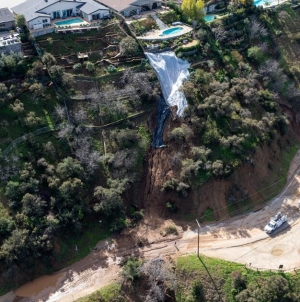-
Summer of 2023 was hottest in 2,000 years, study finds - May 14, 2024
-
A portion of Mulholland Drive, damaged by mudslides in winter storms, reopens - May 26, 2024
-
‘Maybe You Don’t Want to Win’ - May 26, 2024
-
Donald Trump Putting Law Enforcement in Danger: Attorney - May 25, 2024
-
Avoid the waters of these 5 L.A. County beaches this holiday weekend, public health officials say - May 25, 2024
-
Bawdy Comedy ‘Anora’ Wins Palme d’Or at Cannes Film Festival - May 25, 2024
-
Map Shows Heat Wave Zone Spread Into Five New States - May 25, 2024
-
Azusa police arrest suspected slingshot-wielding vandal - May 25, 2024
-
Donald Trump Hammers Judge Ahead of Jury Instructions - May 25, 2024
-
Sometimes U.S. and U.K. Politics Seem in Lock Step. Not This Year. - May 25, 2024
Summer of 2023 was hottest in 2,000 years, study finds
An extreme summer marked by deadly heat waves, explosive wildfires and record-warm ocean temperatures will go down as among the hottest in the last 2,000 years, new research has found.
The summer of 2023 saw the temperature in the Northern Hemisphere soar 3.72 degrees above the average from 1850 to 1900, when modern instrumental recordkeeping began, according to a study published Tuesday in the journal Nature. The study focused on surface air temperatures across the extra-tropical region, which sits at 30-90 degrees north latitude and includes most of Europe and North America.
June, July and August last year were also 3.96 degrees warmer than the average from the years 1 through 1890, which the researchers calculated by combining observed records with tree ring records from nine global regions.

Aggressive and impactful reporting on climate change, the environment, health and science.
Jan Esper, the study’s lead author and a professor of climate geography at Johannes Gutenberg University in Germany, said that he was not expecting summer last year to be quite so anomalous, but that he was ultimately not surprised by the findings. The high temperatures built on an overall warming trend driven by greenhouse gas emissions and were further amplified by the onset of El Niño in the tropical Pacific.
“It’s no surprise — this really, really outstanding 2023 — but it was also, step-wise, a continuation of a trend that will continue,” Esper told reporters Monday. “Personally I’m not surprised, but I am worried.”
He said it was important to place 2023’s temperature extreme in a long-term context. The difference between the region’s previous warmest summer, in the year 246, and the summer of 2023 is 2.14 degrees, the study found.
The heat is even more extreme when compared with the region’s coldest summers — the majority of which were influenced by volcanic eruptions that spewed heat-blocking sulfur into the stratosphere. According to the study, 2023’s summer was 7.07 degrees warmer than the coldest reconstructed summer from this period, in the year 536.
“Although 2023 is consistent with a greenhouse gases-induced warming trend that is amplified by an unfolding El Niño event, this extreme emphasizes the urgency to implement international agreements for carbon emission reduction,” the study says.
The sweltering summer temperatures contributed to scores of heat illnesses and deaths, including at least 645 heat-associated deaths in Maricopa County, Ariz., where Phoenix saw temperatures of 110 degrees or hotter for a record 31 consecutive days.
Wildfires exacerbated by high temperatures raged across Canada and sent hazardous smoke down the East Coast of the United States and across the Atlantic. Meanwhile, ocean temperatures off the coast of Florida soared above 101 degrees, the temperature of a hot tub.
Multiple climate agencies, including the National Oceanic and Atmospheric Administration and the European Union’s Copernicus Climate Change Service, declared 2023 the hottest year on record globally.
Notably, Copernicus found that the summer months of June, July and August last year measured 1.18 degrees warmer than average — still hot, but not nearly as warm as the study’s findings for the Northern Hemisphere’s extra-tropical region.
That region was especially hot in part because it is home to so much land, which warms faster than oceans, said Karen McKinnon, an assistant professor of statistics and the environment at UCLA who did not work on the study. (June, July and August are also winter months in the Southern Hemisphere.)
McKinnon said the study’s findings are not unexpected, as there was already good evidence that the summer of 2023 was record-breaking when compared with measurable data going back to the mid-1800s. But by going back 2,000 years, the researchers also helped illuminate “the full range of natural variability that could have occurred in the past,” she said.
She noted that tree rings can serve as a helpful proxy for climate conditions in the past, as trees tend to grow more in a given year if they receive the right amount of warmth, water and sunshine.
But although last year’s heat was undeniable, the study also underscores that the summer temperature in this region was notably higher than the global target of 2.7 degrees — or 1.5 degrees Celsius — of warming over the preindustrial period, which was established by the Intergovernmental Panel on Climate Change in 2015.
It also notes that some recent research has found the data used to calculate that baseline may be off by several tenths of a degree, meaning it could need to be recalibrated, with the target landing closer to an even more challenging 1.6 or 1.7 degrees.
“I don’t think we should use the proxy instead of the instrumental data, but there’s a good indication that there’s a warm bias,” Esper said. “Further research is needed.”
McKinnon said there is always going to be some degree of uncertainty when comparing present-day temperatures to past temperatures, but that the 1.5-degree limit is as symbolic as it is literal. Many effects of climate change, including worsening heat waves, have already begun.
“There are definitely tipping points in the climate system, but we don’t understand the climate system well enough to say 1.5 C is the temperature for certain tipping points,” she said. “This is just a policy goal that gives you a temperature change that maybe would be consistent with averting some damages.”
In fact, the study’s publication comes days after a survey of 380 leading scientists from the IPCC revealed deep concerns about the world’s ability to limit global warming to 1.5 degrees. That report, published last week in the Guardian, found that only 6% of surveyed scientists think the 1.5-degree limit will be met. Nearly 80% said they foresee at least 2.5 degrees Celsius of warming.
The report caused a stir among the scientific community, with some saying it focused too heavily on pessimism and despair. But Daniel Swain, a climate scientist with UCLA who participated in the survey, said its findings are worthy of consideration.
“There are many kinds of scientists, myself included, who are very worried and concerned and increasingly alarmed by what is going on and what the data is showing,” Swain said during a briefing Friday. “But if anything, I think that really results in a stronger sense of resolve and urgency to do even more, and to do better.”
Indeed, while scientists continue to weigh in on whether — or how quickly — humanity can alter the planet’s worsening warming trajectory, Esper said he hopes the latest study will serve as motivation for changing outdated modes of energy consumption that contribute to planet-warming greenhouse gases.
“I am concerned about global warming — I think it’s one of the biggest threats out there,” he said.
He added that he is particularly worried for his children and for younger generations who will bear the brunt of worsening heat and other adverse climate outcomes. There is a strong likelihood that the summer of 2024 will be even hotter, the study says.
“The longer we wait, the more extensive it will be, and the more difficult it will be to mitigate or even stop that process and reverse it,” Esper said. “It’s just so obvious: We should do as much as possible, as soon as possible.”
Newsletter
Toward a more sustainable California
Get Boiling Point, our newsletter exploring climate change, energy and the environment, and become part of the conversation — and the solution.
You may occasionally receive promotional content from the Los Angeles Times.
Source link
































